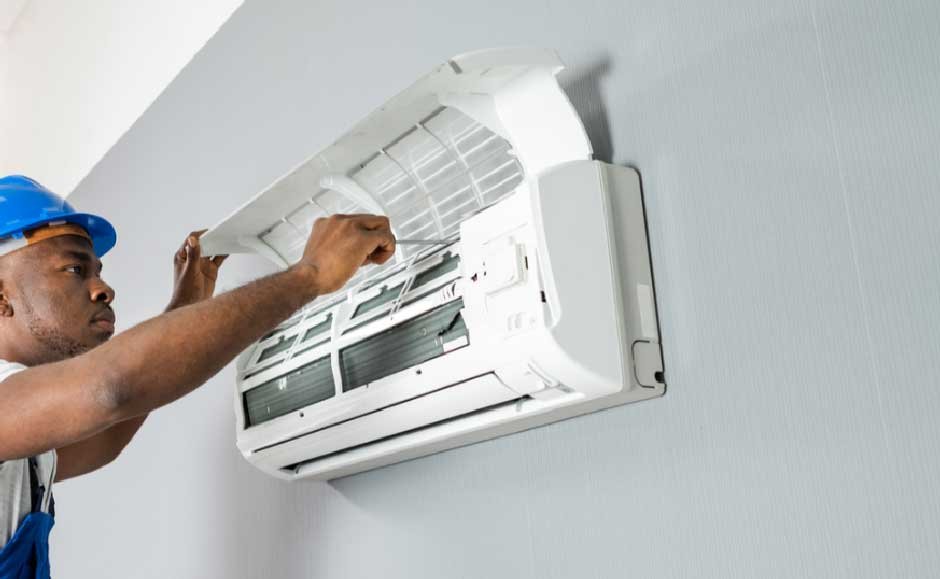Skip to the good bit
ToggleUnderstanding How Modern Air Conditioners Work
The way we cool our homes and businesses has changed a lot over the years. Regular air conditioners have worked fine, but they have some big problems that affect our comfort and our bills. That’s where inverter AC systems come in—they’re changing how the HVAC world works by fixing these old problems.
Inverter AC systems are one of the biggest improvements in cooling technology in many years. They work differently from regular air conditioners, giving you better temperature control, using less energy, and making you more comfortable. But what makes them different, and are they worth the extra money?
In this guide, we’ll cover everything you need to know about inverter AC systems. We’ll explain how they work, their good and bad points, and help you decide if this technology is right for your cooling needs.
How Traditional AC Systems Work
Before diving into inverter technology, let’s briefly review how conventional air conditioners operate. Traditional AC systems use what’s called a “fixed-speed” or “single-speed” compressor. These compressors have only two states: they’re either fully on or completely off.
When you set your desired temperature on a conventional AC, the system runs at full power until it reaches that temperature. Then it shuts off completely. Once the room warms up again beyond your set temperature, the compressor kicks back on at full power. This constant cycling between on and off is known as the “start-stop cycle.”
This approach to cooling has been the standard for decades, but it comes with several problems:
- The frequent starting and stopping process consumes a lot of energy.
- The temperature in your space fluctuates noticeably as the system cycles.
- The loud start-up noise occurs repeatedly throughout the day.
- Components wear out faster due to the stress of frequent cycling.
These drawbacks lead to higher energy bills, inconsistent comfort, and potentially shorter system lifespan—problems that have driven the development of inverter technology.
What Is an Inverter AC System?
An inverter AC system is a big change in air conditioning technology. Unlike regular units, inverter AC systems can change their running speed. They don’t just turn on and off—they adjust how much cooling they provide based on what your room needs at that moment.
The main part of an inverter AC is its adjustable-speed compressor. This compressor can run at different speeds based on how much cooling you need. When you first turn on an inverter AC, it runs at high speed to cool the room quickly. Once it reaches your set temperature, instead of shutting off, the system slows down and runs at a lower speed to keep that temperature.
Think of it like driving a car: A regular AC is like a car that can only go full speed or be completely stopped—nothing in between. An inverter AC is like a car with a gas pedal that can go at any speed needed.
This ability to change its running speed is what makes inverter AC systems save more energy and keep you more comfortable than regular air conditioners.
How Inverter Technology Works
The name “inverter” comes from the electronic part that controls how fast the compressor motor runs. Here’s a simple explanation of how it works:
- Power changing: The inverter changes the incoming electricity (AC power) to DC power.
- Speed adjusting: It then changes the DC power back to AC, but at different speeds.
- Motor control: These different speeds let it control exactly how fast the motor runs.
- Always running: Instead of turning on and off, the compressor runs all the time, but at different speeds.
When your room needs more cooling, the inverter makes the compressor run faster. When less cooling is needed, it slows the compressor down. This constant adjusting makes sure the system gives exactly the right amount of cooling to keep your set temperature.
This works like the speed control on modern ceiling fans or the cruise control in your car—they all change their power to keep things steady.
Benefits of Inverter AC Systems
The unique operating principle of inverter AC systems leads to several significant advantages:
Energy Savings
Inverter AC systems use much less energy than regular models. By getting rid of the start-stop cycle and running at just the right speed, they can cut electricity use by 30-50% compared to regular air conditioners.
This saving comes from two main things:
- The compressor rarely runs at full power once the room is cool.
- It doesn’t have to use extra power to start up over and over like regular ACs do.
Over time, these savings can really lower your electric bills, especially in hot places where you use air conditioning a lot.
Consistent Temperature Control
One of the most noticeable benefits of inverter AC systems is the consistent comfort they provide. Traditional ACs create temperature swings of 2-4 degrees as they cycle on and off. Inverter systems maintain temperature within 1 degree of your setting by continuously adjusting their output.
This precise temperature control means you’ll never experience those uncomfortable warm-ups as you wait for the AC to kick back on. The room stays at your preferred temperature without noticeable fluctuations.
Quieter Operation
Because inverter systems rarely operate at full capacity and don’t frequently start and stop, they run much more quietly than conventional air conditioners. The loudest part of an AC’s operation is typically during startup, which inverter systems minimize by running continuously.
Additionally, many inverter ACs include “quiet” or “sleep” modes that reduce fan speeds during nighttime hours for even less noise disruption.
Faster Initial Cooling
When you first turn on an inverter AC, it operates at maximum capacity to cool your space quickly. This means you’ll reach your desired temperature faster than with a conventional system.
Traditional ACs can only run at 100% capacity, but some inverter systems can temporarily exceed their rated capacity (a feature called “boost” or “turbo” mode) to provide even faster initial cooling when needed.
Longer System Lifespan
The constant starting and stopping of conventional air conditioners puts significant stress on the compressor and other components. By eliminating this cycling, inverter systems reduce wear and tear on these parts.
Many manufacturers estimate that inverter AC systems can last 30-50% longer than conventional models because of this reduced mechanical stress. This longer lifespan helps offset the higher initial cost of inverter technology.
Drawbacks to Consider
Despite their many advantages, inverter AC systems aren’t perfect. Here are some potential drawbacks to consider:
Higher Initial Cost
The most significant barrier to adopting inverter technology is the upfront cost. Inverter AC systems typically cost 20-40% more than comparable conventional models. This price premium reflects the more sophisticated electronics and variable-speed compressor technology.
While the energy savings will eventually offset this higher purchase price, the longer payback period may not make sense for everyone, particularly those in mild climates where air conditioning is used infrequently.
More Complex Repairs
The advanced electronics that make inverter systems so efficient also make them more complicated to repair. When problems do occur, they often require specialized knowledge and tools.
Repair costs for inverter systems tend to be higher than for conventional ACs, and in some areas, it may be challenging to find technicians with experience working on these systems.
Performance in Extreme Conditions
While inverter AC systems generally perform well across a wide range of conditions, some models may struggle in extreme temperatures. In regions with very high outdoor temperatures (above 110°F/43°C), the efficiency advantage of inverter systems may be reduced.
It’s important to choose an inverter AC system rated appropriately for your climate to ensure optimal performance.
Cost Comparison: Inverter vs. Conventional AC
To understand the true cost difference between inverter and conventional AC systems, we need to look beyond just the purchase price:
Initial Investment
For a typical 1-ton (12,000 BTU) residential system:
- Conventional AC: $2,500-3,500 installed
- Inverter AC: $3,200-4,500 installed
This represents roughly a 30% premium for inverter technology in most markets.
Energy Costs
The energy savings from an inverter system depend on your usage patterns and local electricity rates, but here’s a representative example:
- Average cooling season electricity cost with conventional AC: $400-600
- Average cooling season electricity cost with inverter AC: $240-420
This represents annual savings of $160-180 on average, though savings can be higher in hot climates or homes with longer cooling seasons.
Lifetime Value
When factoring in the longer lifespan and reduced energy costs:
- Conventional AC: $8,000-10,000 (purchase price + energy costs over 10-year lifespan)
- Inverter AC: $7,500-9,500 (purchase price + energy costs over 15-year lifespan)
Despite the higher upfront cost, inverter systems often provide better lifetime value due to their energy efficiency and durability.
Is an Inverter AC Right for You?
Deciding whether an inverter AC system makes sense for your situation depends on several factors:
Consider an Inverter AC If:
- You use air conditioning frequently or for extended periods.
- Energy efficiency and lower utility bills are priorities.
- You’re sensitive to temperature fluctuations or AC noise.
- You plan to stay in your current home for 5+ years.
- You live in an area with high electricity rates.
A Conventional AC Might Be Better If:
- You’re on a tight budget and need the lowest possible initial cost.
- You use air conditioning infrequently or live in a mild climate.
- You plan to move within the next few years.
- Your space is used intermittently (like a vacation home).
The general rule of thumb: The more you use your air conditioner, the more you’ll benefit from inverter technology.
Maintenance Requirements
Proper maintenance is essential for any air conditioning system. For inverter AC systems, some key maintenance considerations include:
Regular Filter Cleaning
Clean or replace air filters every 1-2 months during regular use. Dirty filters restrict airflow, which forces inverter systems to run at higher speeds and reduces their efficiency advantage.
Professional Check-ups
Schedule professional maintenance at least once per year. The technician should:
- Check refrigerant levels
- Clean coils and drain lines
- Inspect electrical components
- Verify proper operation of the inverter control
Power Quality Concerns
Inverter systems can be sensitive to power quality issues such as voltage fluctuations. In areas with unreliable electricity, consider installing a voltage stabilizer to protect your investment.
With proper maintenance, an inverter AC system should provide reliable service for 15-20 years—significantly longer than the 10-12 year average of conventional systems.
The Future of AC Technology
Inverter technology represents a significant step forward, but innovation in air conditioning continues. Some emerging trends include:
Integration with Smart Home Systems
Modern inverter AC systems increasingly feature smart connectivity, allowing them to integrate with home automation systems. This connectivity enables features like:
- Remote temperature adjustment via smartphone
- Occupancy-based operation using motion sensors
- Integration with weather forecasts to optimize cooling strategies
Refrigerant Evolution
The HVAC industry continues to transition toward more environmentally friendly refrigerants. Newer inverter AC systems often use refrigerants with lower global warming potential, contributing to their overall environmental benefits.
Hybrid Cooling Solutions
Some manufacturers are developing hybrid systems that combine inverter technology with alternative cooling methods like evaporative cooling. These hybrids aim to provide maximum efficiency across different climate conditions.
As energy efficiency standards become more stringent worldwide, inverter AC systems are likely to become the new norm rather than a premium option.
Making Your Choice
As air conditioning technology keeps improving, inverter systems are leading the way toward more efficient home cooling. While they cost more upfront, they offer real benefits in comfort, energy savings, and long-term value. Before making your decision, think about how much you use your AC, how long you plan to stay in your home, and what matters most to you—upfront savings or long-term efficiency.
The right choice depends on your specific needs, but understanding how inverter AC systems work helps you make a smarter decision for your cooling needs. With their growing popularity and falling prices, inverter technology may soon become the standard way we all keep cool.







